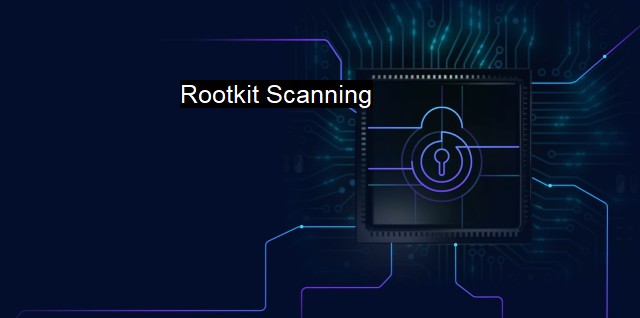What is Rootkit Scanning?
Uncovering and Eliminating Rootkits: The Importance and Process of Rootkit Scanning in Cybersecurity
Rootkit scanning is a vital cybersecurity measure that seeks to detect and purge rootkits from a computer system. It involves using software, often an antivirus tool specifically designed to seek out rootkits, to identify unwelcome and invasive programs. Not all malware scanners are effective at detecting these versatile and stealthy programs, and hence a specialized initiative dubbed “rootkit scanning” is essential.A rootkit is a software, typically malicious, that enables unauthorized levels of control over a computer system without being detected. These uninvited guests are a nefarious form of firmware, which may infiltrate a computer to steal data, corrupt files, manipulate users’ actions, remotely control the computer, or create a network to further distribute malware. They are termed as rootkits for their capacity to gain root-level access to a system, the highest level of access achieved in software systems.
Rootkits operate very discreetly, becoming part of the computer’s operating system, spanning across its various levels, sometimes even attaining kernel-level access. A feature of kernel-level-rootkit is that it's able to manipulate the kernel’s tasks because of its privileged access, rendering it powerful, insidious, and difficult to detect.
Contextually, rootkits stand out due to their capability of self-concealment. Using several techniques like DLL (Dynamic Link Library) injection, hooking, or patching, rootkits can modify system calls and filters to hide their activities and existence, including their related processes, files, and registry keys. This chameleon-like characteristic often allows rootkits to go unnoticed by general antivirus software; hence, rootkit scanning becomes indispensable.
Rootkit scanning procedures are designed specifically to overcome these challenges. They employ various techniques to detect rootkits. Some scanners work by comparing the results from system API (Application Programming Interface) and lowest-level disk reading, checking for discrepancies. If certain files or processes are visible at the disk level but not through the system API, it could signal a rootkit’s presence. Other scanners use a heuristical approach, analysing code for instructions or behaviors normally associated with rootkits.
The integrated rootkit scanning feature that comes with certain antivirus software also searches for temporary files and changed file signatures, considering these as potential attributes of a rootkit infection. They endeavour to determine the sinister intention behind any suspicious shift in the software behaviour. The results may not always display a rootkit explicitly but indicate adequately that a deeper analysis of the system is needed.
Handling the rootkit infection post-detection is as significant as the scanning part itself. Manual removal of rootkit is complicated and could inadvertently damage the system's proper functioning. Often the best option is using an antivirus or other professional cybersecurity tool designed to deal with rootkits aggressively. These tools ensure the complete removal of rootkit and repair any underlying corrupt firmware/software. Professional cybersecurity services might be needed when the infection is too severe for handling with commercially available software.
Although rootkit scanning is crucial, focusing on a proactive defence strategy against these threats would reduce dependence on scans. Regular software updates, careful download inspections, and the use of trusted vendors can diminish rootkit risks to a large extent. On top of it, enabling automatic updates of antivirus software offering rootkits scanning features can keep the defenses up-to-date.
In spite of the odds, it’s reassuring to have rootkit scanning technologies and protocols persistently advancing, growing more adept at tracking even the most elusive and stealthy rootkits. These tools fit into the overall cybersecurity suite, acting as an essential instrument in maintaining secure environments.
Rootkit scanning accentuates the significance of a multilayered protection mechanism in digital security. It exemplifies how defensive strategies should entail specialized procedures to keep evolving threats at bay. Rootkit scanning, therefore, carries a fundamental role in cybersecurity and should be integrated into standard operating procedures when managing antivirus strategies for corporations, and individual users alike.

Rootkit Scanning FAQs
What is a rootkit scanner?
A rootkit scanner is a tool used in cybersecurity to detect and remove rootkits. A rootkit is a type of malware that is designed to hide its presence on a computer system, which can make it difficult for traditional antivirus software to detect.How does a rootkit scanner work?
A rootkit scanner works by scanning the system's files and memory for any suspicious activity or hidden processes. It compares these results to known signatures of rootkits or anomalous behavior to identify the presence of a rootkit.Do all antivirus programs include a rootkit scanner?
No, not all antivirus programs include a rootkit scanner. Traditional antivirus software may not have the capability to detect a rootkit since it is designed to remain undetected. You may need to use specialized rootkit scanning software to detect and remove rootkits.What are the benefits of using a rootkit scanner?
Using a rootkit scanner can help protect your computer from stealthy malware that may go undetected by traditional antivirus programs. It can also help identify any existing rootkits on your system, allowing you to remove them and prevent further damage or unauthorized access. Additionally, regular rootkit scans can help prevent future infections by detecting any suspicious activity early on.| | A | | | B | | | C | | | D | | | E | | | F | | | G | | | H | | | I | | | J | | | K | | | L | | | M | |
| | N | | | O | | | P | | | Q | | | R | | | S | | | T | | | U | | | V | | | W | | | X | | | Y | | | Z | |
| | 1 | | | 2 | | | 3 | | | 4 | | | 7 | | | 8 | | |||||||